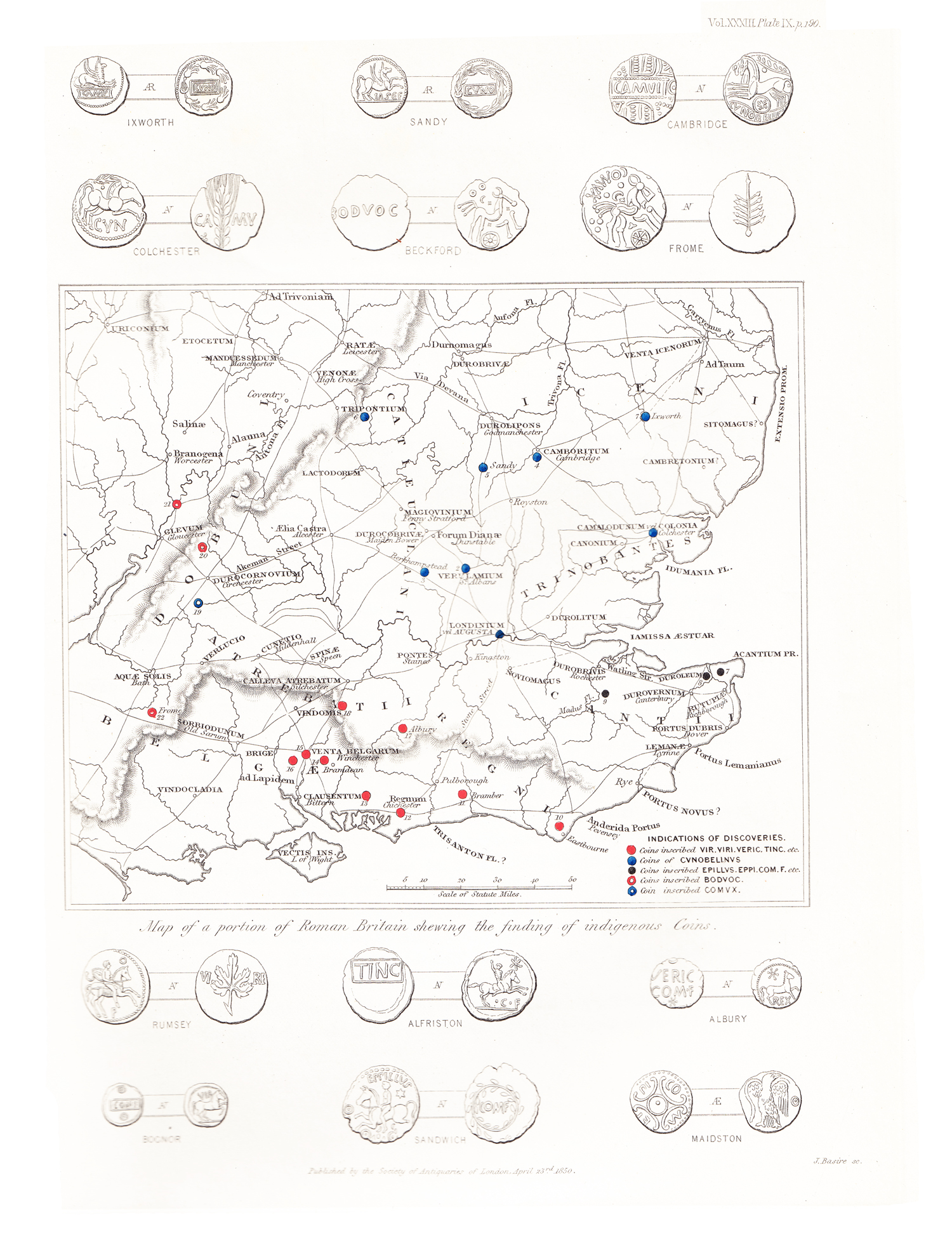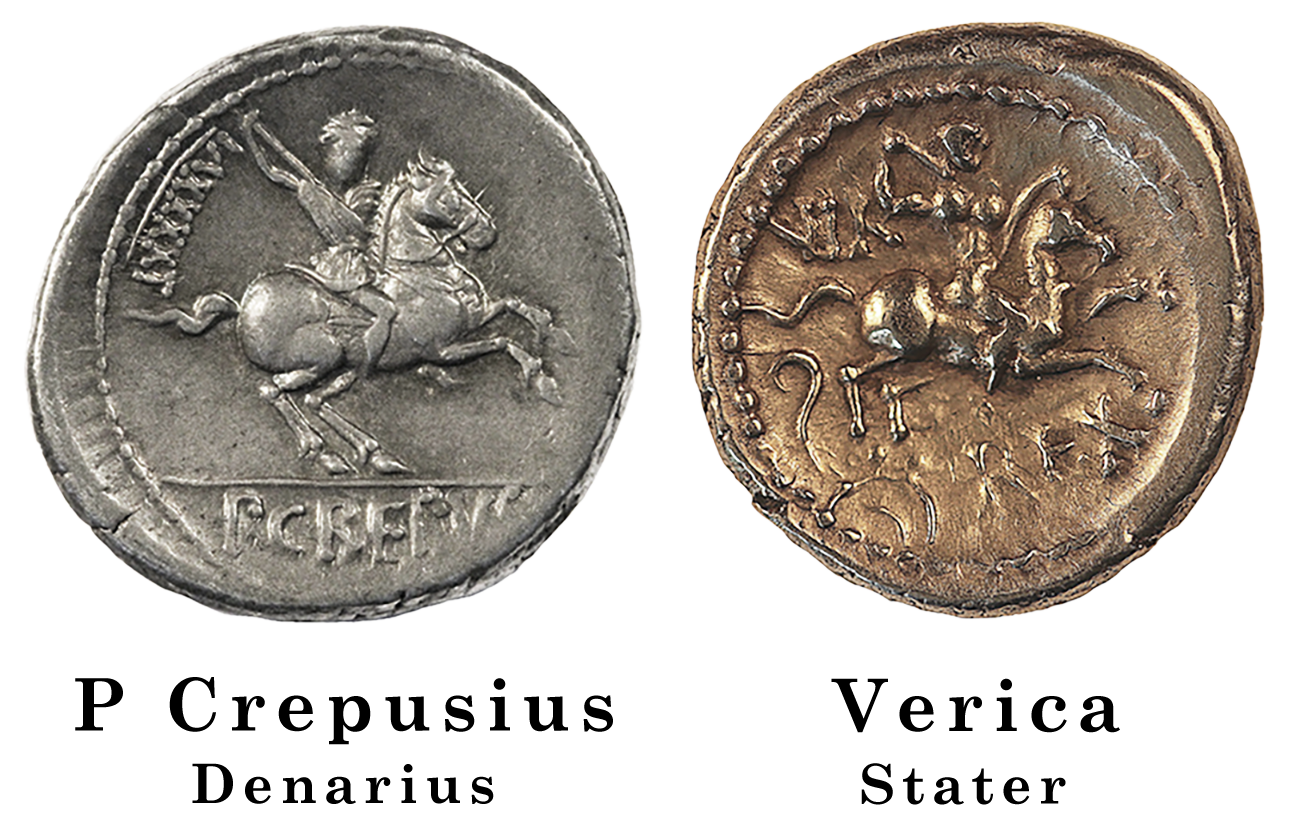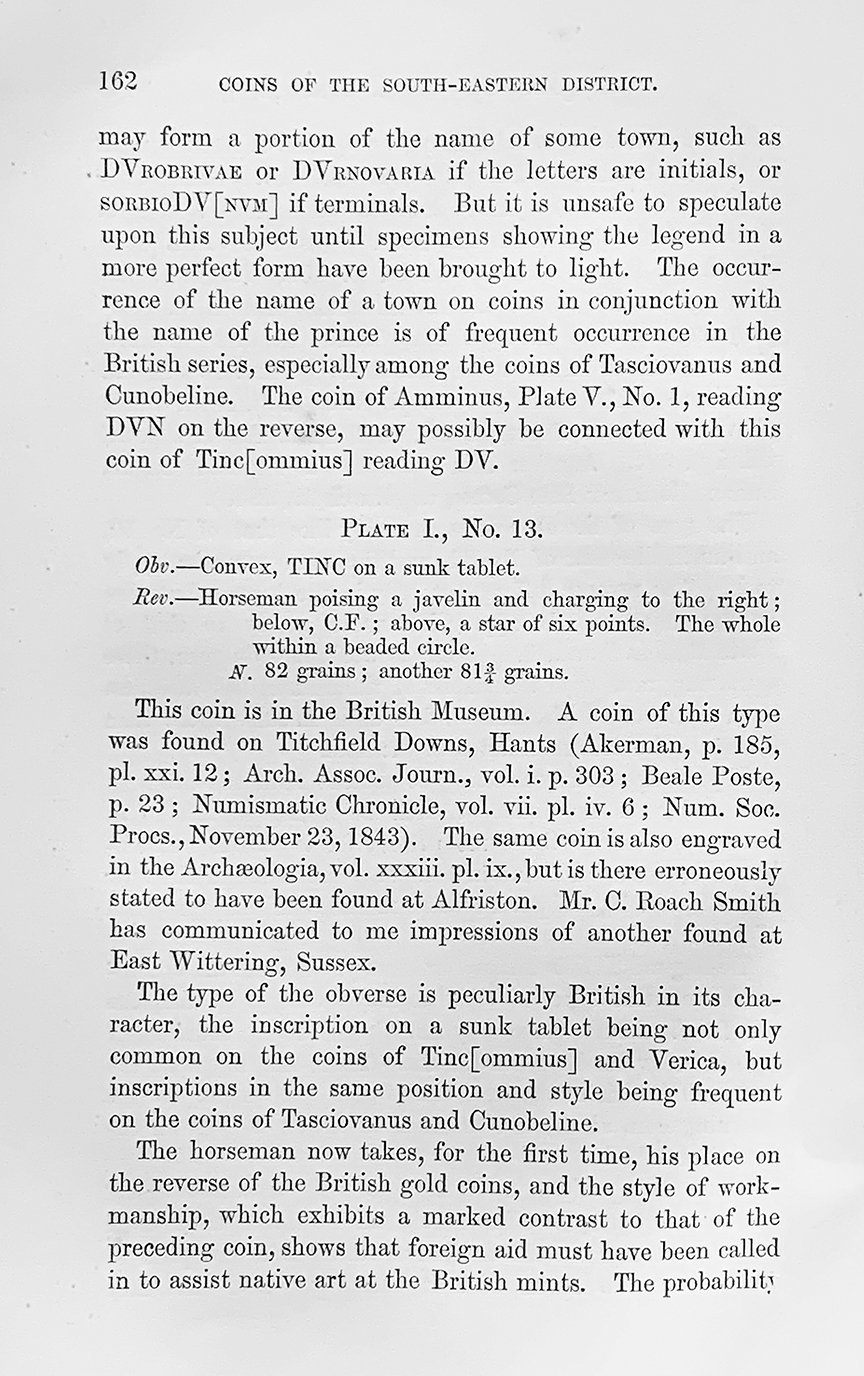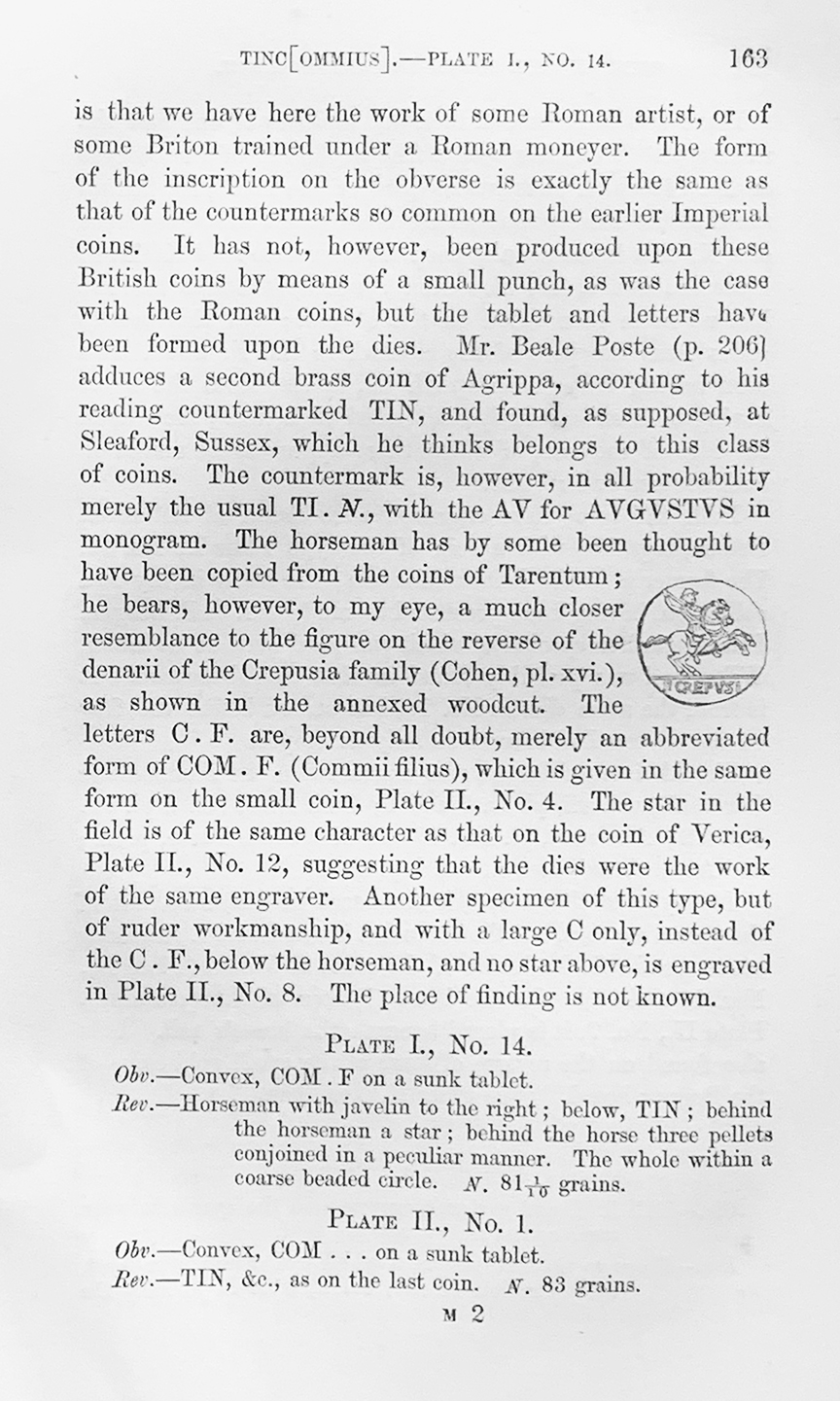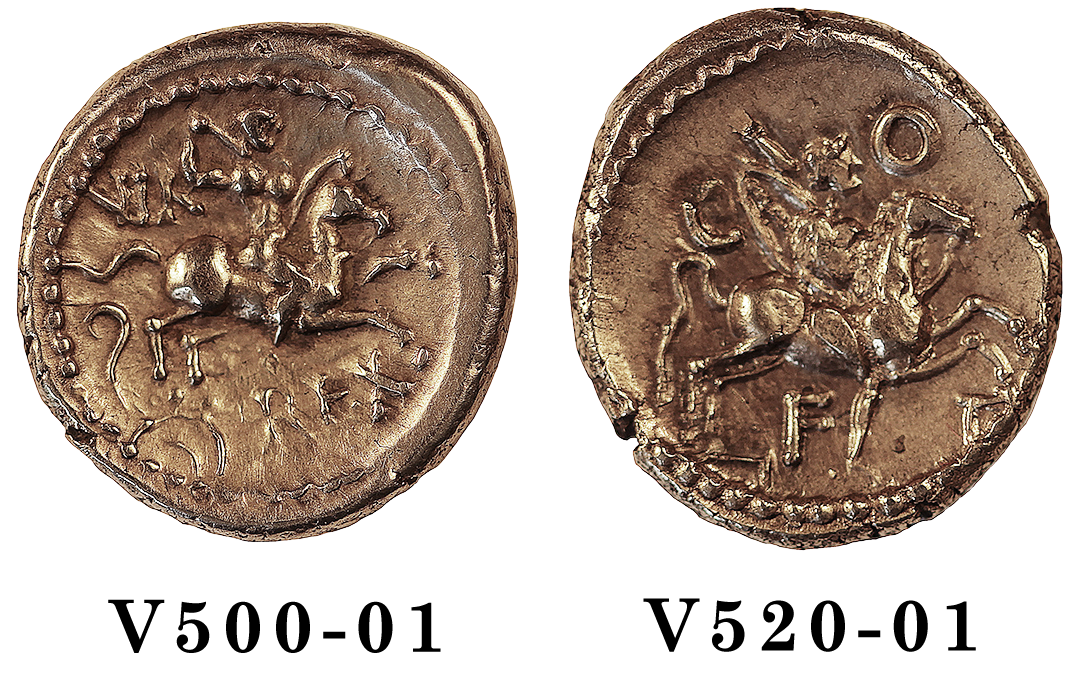
Numismatic Articles
Van Arsdell 2023a (Info)
Semiotics of Celtic Coins XX – Verica Rolls the Dice
By Robert D. Van Arsdell
Introduction
In the middle of his reign, Verica changed all the images on his gold staters. This was a radical change. It suggests he faced a problem and had to do something about it. We know from Dio that he was deposed and fled to Rome a few years later. So whatever he tried – it didn't work.
The old images had been introduced forty years before, by Tincomarus. Verica, for his first two coinages, used these old images. They had become an immobilized type by the middle of his reign. The reverses showed a warrior-on-horseback brandishing a spear. It was an image of power and domination – one designed to show the king as a formidable leader. This was a standard legitimization-of-power claim. (Info)
The new images present a very different ruler. It's curious that more hasn't been made of this change. (Background) After all, the new images were striking. The vine-leaf obverse was entirely new and there were subtle changes to the equestrian figure on the reverse.
What made Verica replace the immobilized type?
By the middle of his reign, Verica was an old man – probably losing grip on power.
Decades before, his brother Tincomarus had faced a revolt. Tincomarus asserted his power with a threat. The equestrian figure, a fierce warrior, proclaimed Tincomarus had the power to destroy his foes. The ploy failed, he was deposed and fled to Rome. (Info)
Verica likely concluded that a weakened leader would fail to assert power with mere imagery. He would have to try something more subtle, more persuasive if he was to keep the throne.
Thus, the Third Coinage of Verica should show us something with dramatic impact, yet subtle in its messaging. Semiotic analysis lets us unravel this story. We start by looking at the images.
Origin of the Horseman Image
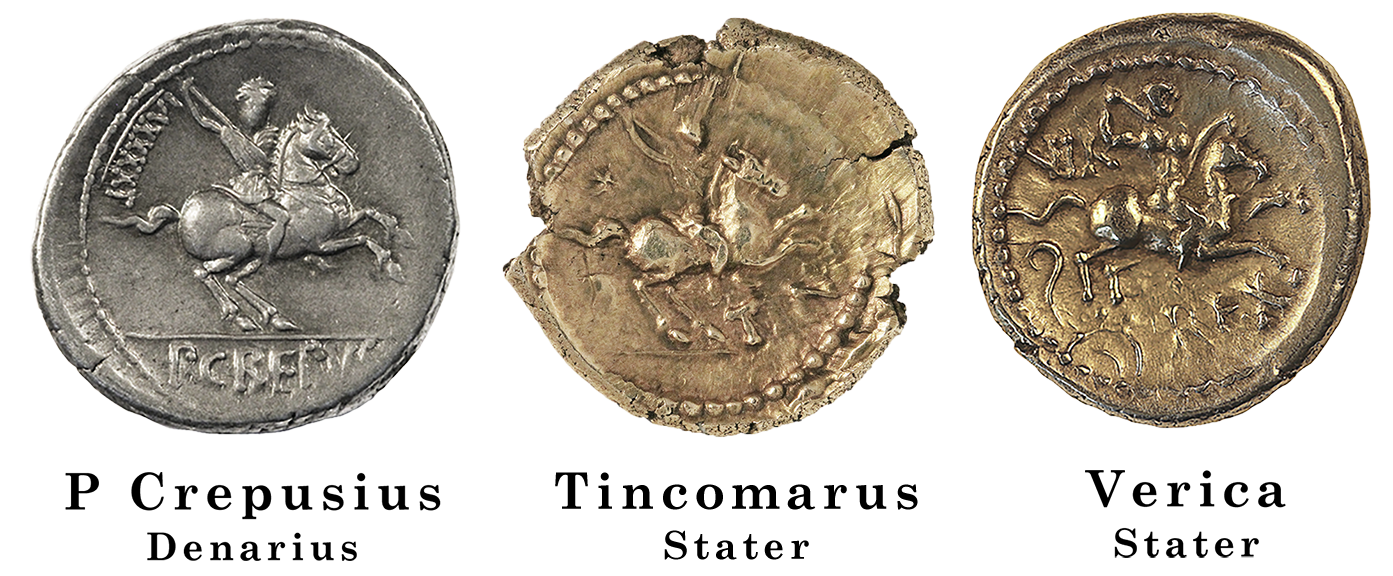
The equestrian figure first appeared on the Second Coinage staters of Tincomarus, sometime in the 20s BC. This was a borrowed image. (Info) The prototype was identified by Evans in 1864 as a Roman denarius of P. Crepusius. (Info)
The horseman was used until the end of Tincomarus' reign. It was briefly dropped during the next ruler, Eppillus, but was promptly reinstated by Verica around 10 AD. Verica used the image for the next 15 years. By 25 AD, it had become an immobilized type.
Suddenly, with his Third Coinage staters, Verica changed everything. He needed to send a new message to his followers. The new equestrian image doesn't appear to have been copied from a Roman prototype. It was purposely created for Verica's new coins. (Info)
A New Look for the Obverse
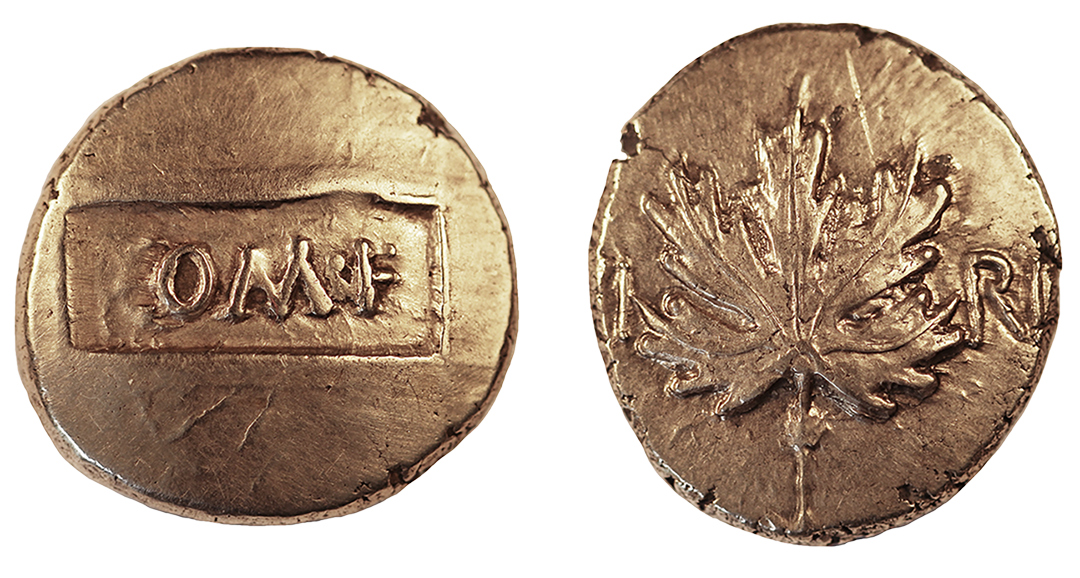
The new obverse image was bold. Verica replaced the COM.F tablet with a vine leaf and his name.
The vine leaf proclaimed prosperity and reminded the elites of Verica's ties to Rome. The VIRI asserted that Verica had created that prosperity.
Also, by this time, Commius was receding from living memory. Verica didn't need to emphasize Commius as much – he could be relegated to "COF" on the other side of the coin.
A New Look for the Horseman
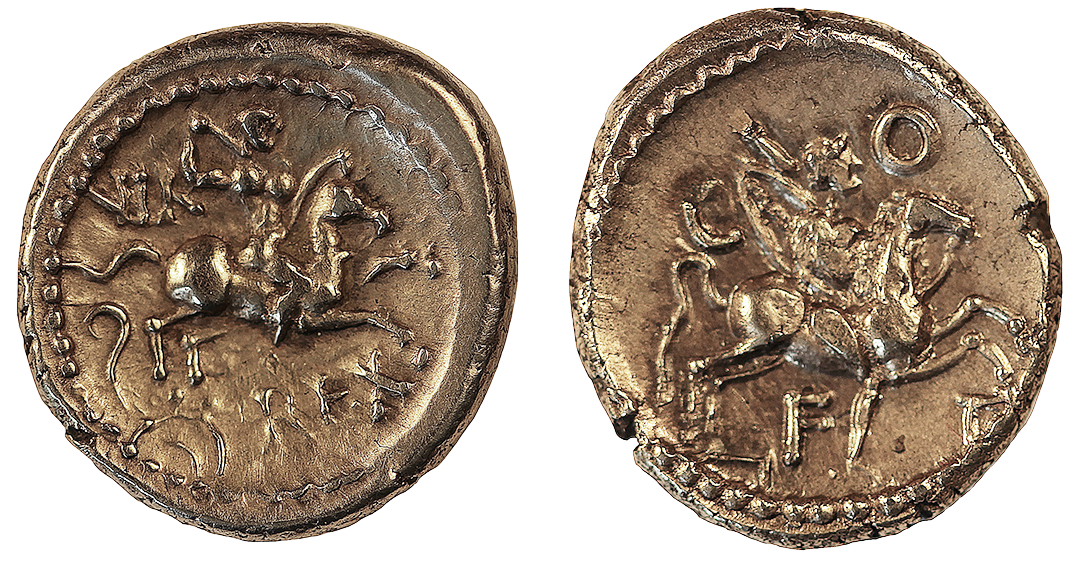
Verica put all the subtlety on the reverse. He made minor, but important changes to the equestrian figure. A simple assertion of power wasn't working any more. Times had changed and he needed a better message to secure his claim to kingship.
He replaced the warrior brandishing a spear with a more relaxed warrior. Verica's new warrior looks more like a horseman in a parade. He's confident and successful – as Verica may have felt as a old man. The horseman doesn't have to engage in warfare anymore, he's made his mark and knows what's best for his elites.
The COF reminded everyone of Verica's link to a successful dynasty.
The Semiotic Analysis
Are the images Replicas or Moderate Inventions?
The images on all of Verica's staters are complex – made up of multiple elements with many Amalgamation Switches. They must relate complicated messages.
Because Verica's two early staters used immobilized types, we might mistake them for Replicas. However, the Tincomarus originals were complex concoctions and were thus Moderate Inventions. Consequently, Verica's first two coinages continued using Moderate Inventions.
When Verica changed his imagery on the Third Coinage, he continued the complexity. But the new images accomplished two things in addition:
- The obverse immediately commanded attention and prompted the viewer to look for changes on the reverse.
- The reverse signaled the important shift in messaging. The more relaxed Parade Horseman gave the rest of the story – a statesman who knew how to deal with Rome and bring prosperity to his people.
All these images should be analyzed as Moderate Inventions.
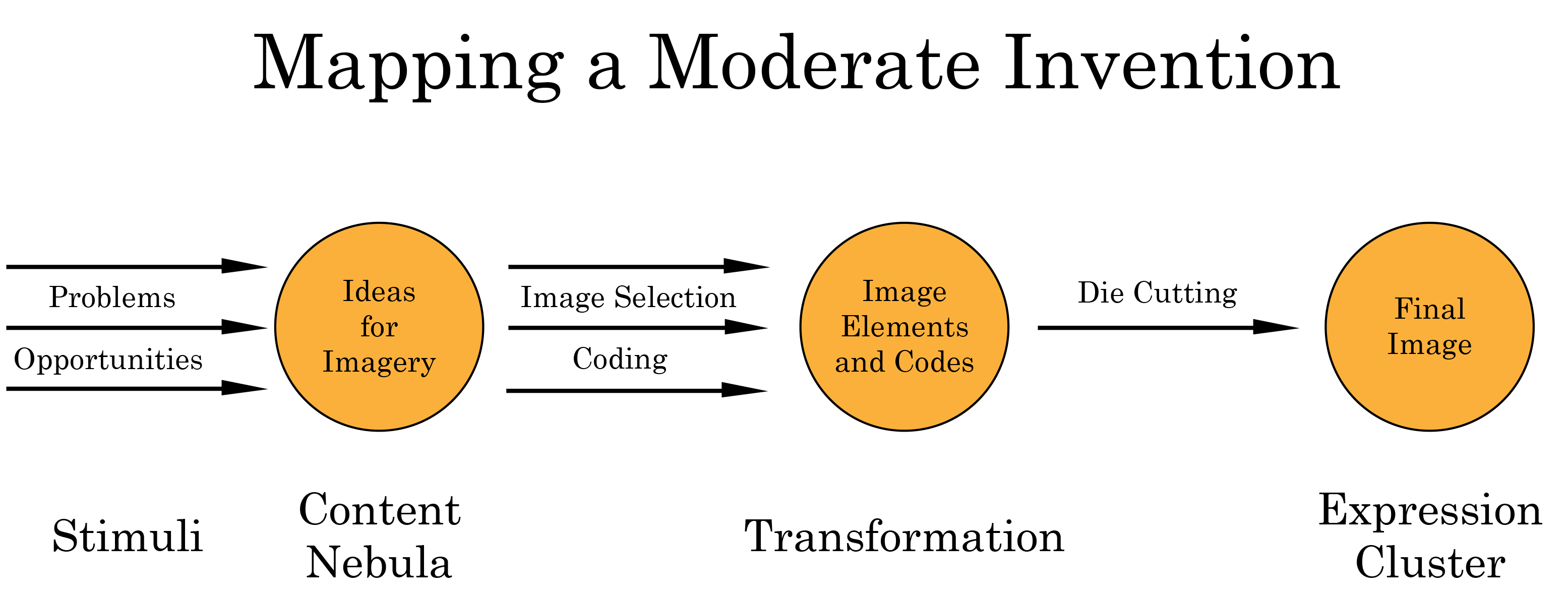
Do the images use borrowed codes?
Tincomarus introduced the Warrior image twenty or thirty years before Verica became King. The Roman prototype had been struck in 82 B.C., another fifty years earlier. It's unlikely either ruler borrowed the Roman code for the image – or even knew the Code.
It's also unlikely that the horseman was intended as the Divine Rider – that it had a religious component borrowed from Roman mythology. The Devine Rider type had fallen out of favour on Roman denarii before the time of Tincomarus. It's more likely that Tincomarus liked the image and gave it a new code (a simple assertion of power).
When Verica came to the throne, he initially continued Tincomarus' Warrior Horse. He could use the this image and expect his elites would not only know the meaning of the horseman, but would notice if he changed anything.
Later, when conditions became unstable, he needed to replace the image. The Roman emperors had come to prefer the Parade Horse for their official images. It promoted them as statesmen and benefactors, rather than ruthless dictators. Verica likely knew of this new preference and changed his imagery to conform to Roman practice. In doing this, he would be emphasizing his role as statesman and benefactor, rather than a powerful despot. (Info)
There is no denarius that can be offered as a obvious prototype for the new image – Verica came to know of the Parade Horse by some other source of inspiration. Perhaps he learned of it directly from the Roman emperors.
The vine leaf appears to be a British innovation entirely – no plausible Roman prototype has been suggested. It likely suggests "the wealth of the realm".
Circumstance Selectors
The Selector for the image creator is Verica, who is sending direct messages to his people. The Selector for the audience would be Verica's wealthy elites, the only people likely to handle gold coins.
The Stimuli
The unsettled political conditions of the time give us the key stimuli. These are more complex than they appear at first. We know that Verica was deposed and exiled to Rome after the introduction of the Third Coinage. Thus, there would have been unsettled conditions in southern Britain. But the Atrebatic rulers were likely friendly kings of the emperor in Rome. Caligula was on the throne in the late 30s AD, soon to be deposed. Unsettled conditions in both lands would be particularly risky for a friendly king.
As Braund points out, a friendly king would have both friends and enemies at Rome. The Roman emperor would, in turn, have enemies who would try to build alliances overseas against the friendly king. The situation was always dangerous – especially for the friendly king. Verica likely became caught up in intriges in both Britain and Rome. (Info)
We can be certain, as well, that Verica knew all the details of the exile of Tincomarus. Tincomarus had probably faced the same kinds of intrigues. Verica would have been anxious not to repeat Tincomarus' mistakes.
The wealth of the Atrebates and other groups south of the Thames should also added to the Stimuli. Wealth would have increased the influence of the elites while giving them something to protect. The elites would have been important allies in maintaining Verica's throne. He had to cultivate their support carefully. (Info)
The Key Stimuli:
- The story of Tincomarus: Tincomarus likely threatened his enemies in Britain. He'd placed menacing images on his coins, but this didn't frighten them. The mistake only made matters worse. (Info)
- Tincomarus had been deposed and exiled. (Info)
- Verica had enemies at home and was in danger of losing his throne. (Info)
- Conditions in Rome were unsettled and Rome's intentions towards Britain were problematic. (Info)
- The Atrebatic elites were wealthy and had much to lose if Verica mishandled the situation
The Content Nebula
Key aspects of the Content Nebula include:
- Verica is faced with intrigues in both Rome and Britain
- Verica must placate his elites to secure his continued rule
- Verica's elites are wealthy and may fear for their future prosperity
- Verica has an opportunity to solidify his bond with his elites
- Both Verica and his elites are faced with a possible Roman invasion
- Verica must convince his elites that he is the leader who can handle this situation
- Verica must do something – but not repeat Tincomarus' mistakes
- Verica has an attractive image to borrow: the Roman Parade Horse that conveys a message of statesmanship
- The Parade Horse also suggests that Verica is savvy to current Roman practices
- The Parade Horse also reminds Verica's elites that he has been a "friendly king" for many years.
- Verica has the image of a vine leaf to remind his elites that the wine trade is only one of the benefits he has provided
The Transformation and Expression Cluster
Use the image of the vine leaf to attract the attention of the elites to a new message. The Code is one of wealth and prosperity.
Use the Roman "Parade Horse" imagery to send a special message to the elites. The Code is the parade horseman is Verica, a statesman and provider of prosperity to the elites.
The Partial Sememe
Differences after the introduction of the Third Coinage are shown in Red
| Warrior Horse Staters | Parade Horse Staters |
|---|---|
| First Denotation obverse: ComF in Box | First Denotation obverse: Vine Leaf |
| First Connotation obverse: ruler is Son of Commius | First Connotation obverse: wealth of the realm |
| First Denotation obverse: VI RI | |
| First Connotation obverse: ruler is Verica | |
| Amalgamation Switch: Verica is creating the wealth of the realm | |
| First Denotation reverse: Warrior Horse | First Denotation reverse: Parade Horse |
| First Connotation reverse: powerful ruler | First Connotation reverse: statesman, protector and creator of wealth |
| First Connotation reverse: ruler is knowledgable about current Roman customs and practices | |
| First Denotation reverse: VIR REX | First Denotation reverse: COF |
| First Connotation reverse: ruler is Verica | First Connotation reverse: Ruler is son of Commius |
| First Denotation reverse: Title "REX" | |
| First Connotation reverse: ruler is "Friendly King" aligned with Rome | |
| Complex Amalgamation Switches (both sides of coin): ruler is powerful and son of an esteemed ancestor | Complex Amalgamation Switches (both sides of coin): ruler is statesman, protector and creator of wealth, one who knows how to deal with Rome and son of an esteemed ancestor |
| Second Denotation: Powerful ruler | Second Denotation: Reliable, experienced ruler |
| Second Connotation: ruler has support of Rome | Second Connotation: ruler has support of Rome |
| Second Connotation: ruler can call on Rome for help | Second Connotation: ruler can call on Rome for help |
| Third Denotation: effective ruler | Third Denotation: effective ruler |
| Third Connotation: ruler can crush revolts against his realm | Third Connotation: ruler is best person to deal with the current, dangerous situation |
| Third Connotation: demands support of elites | Third Connotation: ruler deserves support of elites |
Summary
Tincomarus assertion of power had failed and resulted in his exile many years before.
Verica tried a different approach. He tried to convince his elites that he was no despot, but a statesman and benefactor who had the experience to deal with a dangerous situation. This was an appropriate message to send to his elites.
The fact that Verica was also deposed does not detract from the sophistication of his messaging. There are limits to the effectiveness of propaganda, and rulers can be overwhelmed by circumstances.
Further Possibilities for Research
The Sememe given above was described as a "Partial Sememe" because additional semiotic analysis could expand it considerably.
No consideration was given to the idea that the horse image could have a religious component. The Denotation and Connotations of the religious interactions between the ruler and his elites would expand the Sememe. Archaeological and numismatic information from the religious sites at Wanborough, Hayling Island, Farley Heath, Waltham St. Lawrence, etc. could expand it even further.
The role of Verica as a "Friendly King" could be analyzed to expand the Denotations and Connotations regarding his relationship with his elites.
Further analysis of the unsettled conditions at Rome could be used to revise the Sememe, as well.
Semiotic analysis offers future workers many opportunities for original research.
END

